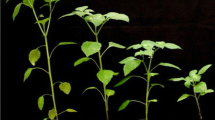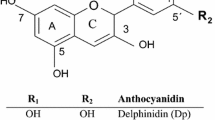Abstract
The dynamic state of antioxidant capacity of flavonoid was investigated for a further demonstration of alleviating the damage of the ultraviolet (UV)-B radiation in the La-treated soybean seedlings under UV-B stress. Using hydroponics culture, the effects of lanthanum on the contents of flavonoid and its ability of antioxidant under elevated ultraviolet-B radiation (280–320 nm) was studied. The results showed flavonoid content in soybean seedlings with UV-B treatment during the stress and convalescent period was increased initially and then decreased, compared with control. Membrane permeability and MDA contents increase at first (first to fifth day) and then decrease (6th–11th day). A similar change of flavonoid content and clearance of flavonoid scavenging \({\text{O}}_2^ - \) and ·OH in soybean seedlings occurred. Flavonoid content and ability of flavonoid scavenging \({\text{O}}_2^ - \) and ·OH in soybean seedlings with La(III) + UV-B treatment were higher than those of UV-B treatment. Meanwhile, membrane permeability and MDA contents in soybean seedlings were lower than those of UV-B treatment. Compared with control, phenylalanine content in soybean seedlings with UV-B treatment is depressed, phenylalanine content in soybean seedlings with La(III) treatment was enhanced. However, phenylalanine content in La(III) + UV-B treatment is not decreased but slightly increased, compared with UV-B treatment. It suggested that the regulative effect of La(III) of the optimum concentration on flavonoid improved the metabolism of ROS, diminished the concentration of MDA and maintained normal plasma membrane permeability, and that its protective effect against low UV-B radiation is superior to that of high UV-B radiation. The defensive effect of La(III) on soybean seedlings under UV-B stress is carried out on the layer of defense system.





Similar content being viewed by others
Abbreviations
- La(III):
-
lanthanum(III)
- MDA:
-
malonaldehyde
- \({\text{O}}_2^ - \) :
-
Superoxide radical
- ·OH:
-
hydroxyl radical
- UV-B:
-
ultraviolet-B radiation
- RMP:
-
relative membrane permeability
- SOD:
-
superoxide dismutase
- PAL:
-
phenylalanine ammonia-lyase
- Phe:
-
phenylalanine
- ROS:
-
reactive oxygen species
References
Harborne JB, Williams CA (2000) Advances in flavonoid research since 1992. Phytochemistry 55:481–504
Frohnmeyer H, Staiger D (2003) Ultraviolet-B radiation-mediated responses in plants. Balancing damage and protection. Plant Physiol 133:1420–1428
Pourcel L, Routaboul JM, Cheynier V et al (2007) Flavonoid oxidation in plants: from biochemical properties to physiological functions. Trends Plant Sci 12:29–36
Huang XH, Zhou Q, Zhang GS (2005) Advances on rare earth application in pollution ecology. J Rare Earths 23:5–11
Caldwell MM (1977) Restarch in photobiology. Plenum, New York, pp 13–17
Arvouet-Grand A, Vennat B, Pourrat A et al (1994) Standardisation d’un extrait de propolis et identification des principaux constituants. J Pharm Belg 49:462–468
Dhindsa RS, Plumbdhindsa P, Thorpe TA (1981) Leaf senescence—correlated with increased levels of membrane-permeability and lipid-peroxidation, and decreased levels of superoxide-dismutase and catalase. J Exp Bot 32:93–101
Janero DR (1990) Malondialdehyde and thiobarbituric acid-reactivity as diagnostic indexes of lipid-peroxidation and peroxidative tissue-injury. Free Radical Biol Med 9:515–540
Yu HH, Seo SJ, Kim YH et al (2006) Protective effect of Rehmannia glutinosa on the cisplatin-induced damage of HEI-OC1 auditory cells through scavenging free radicals. J Ethnopharmacol 107:383–388
Halliwell B, Gutteridge JMC, Aruoma OI (1987) The deoxyribose method—a simple test-tube assay for determination of rate constants for reactions of hydroxyl radicals. Anal Biochem 165:215–219
Osborne DR, Voogt P (1978) The analysis of nutrients in foods. Academic, New York (USA), pp 239–240
Zhao D, Reddy KR, Kakani VG et al (2003) Growth and physiological responses of cotton (Gossypium hirsutum L.) to elevated carbon dioxide and ultraviolet-B radiation under controlled environmental conditions. Plant Cell Environ 26:771–782
Liang CJ, Huang XH, Zhou Q (2005) Effect of rare earths on plant under supplementary ultraviolet-B radiation: I effect of cerium on growth and photosynthesis in rape seedlings exposed to supplementary ultraviolet-B radiation. J Rare Earth 23:569–575
Grotewold E (2006) The genetics and biochemistry of floral pigments. Annu Rev Plant Biol 57:761–780
Liang B, Zhang GS, Zhou Q (2006) Effect of Lanthanum on the content of flavonoids in soybean seedling under ultraviolet-B stress: I effect of Lanthanum on total flavonoids. J Agro-Environ Sci 25:584–586
Salin ML (1988) Toxic oxygen species and protective systems of the chloroplast. Physiol Plantarum 72:681–689
Xie ZB, Zhu JG, Chu HY et al (2003) Effect of lanthanum on rice growth and physiological parameters with split-root nutrient solution culture. J Rare Earth 21:86–91
Peng Q, Peng Q, Zhou Q (2008) Effect of lanthanum on the flavonoids in the soybean seeding under Ultraviolet-B stress: II effect on content of flavonoids. J Agro-Environ Sci 27:462–466
Nitz GM, Grubmuller E, Schnitzler WH (2004) Differential flavonoid response to PAR and UV-B light in chive (Allium schoenoprasum L.). Acta Hort 659:825–830
Amic D, Davidovic-Amic D, Beslo D (2003) Structure-radical scavenging activity relationships of flavonoids. Croat Chem Acta 76:55–61
Zhang HY, Chen DZ (2000) Theoretical elucidation on activity differences of ten flavonoid antioxidants. Acta Bioch Bioph Sin 32:317–321
Heim KE, Tagliaferro AR, Bobilya DJ (2002) Flavonoid antioxidants: chemistry, metabolism and structure—activity relationships. J Nutr Biochem 13:572–584
Acknowledgments
This work was financially supported by Project supported by the National Natural Science Foundation of China (30570323) and the Foundation of State Planning Committee (IFZ20051210).
Author information
Authors and Affiliations
Corresponding author
Rights and permissions
About this article
Cite this article
Peng, Q., Zhou, Q. Antioxidant Capacity of Flavonoid in Soybean Seedlings under the Joint Actions of Rare Earth Element La(III) and Ultraviolet-B Stress. Biol Trace Elem Res 127, 69–80 (2009). https://doi.org/10.1007/s12011-008-8218-4
Received:
Accepted:
Published:
Issue Date:
DOI: https://doi.org/10.1007/s12011-008-8218-4




